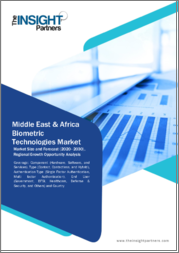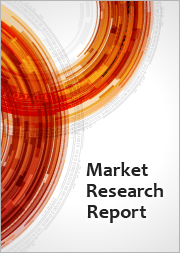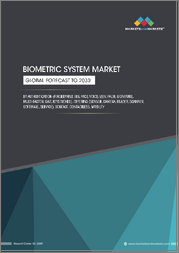
|
시장보고서
상품코드
1567842
아시아태평양의 생체인식 기술 시장 예측(-2030년) : 지역 분석 - 구성요소별, 유형별, 인증 유형별, 최종사용자별Asia Pacific Biometric Technologies Market Forecast to 2030 - Regional Analysis - by Component, Type, Authentication Type, and End User |
||||||
아시아태평양의 생체인식 기술 시장은 2022년 111억 5,440만 달러로 평가되며, 2030년에는 354억 3,918만 달러에 달할 것으로 예상되며, 2022년부터 2030년까지 15.5%의 CAGR을 기록할 것으로 추정됩니다.
보안 수준을 강화하는 기술 발전으로 아시아태평양의 생체인식 기술 시장 성장 촉진
생체인식 기술의 기술 발전은 다양성, 보안 및 대중에 대한 접근성 강화에 초점을 맞추고 있습니다. 인공지능(AI)과 머신러닝(ML)은 생체인식 시스템의 정확성과 신뢰성을 더욱 향상시켜 위양성 및 위음성의 가능성을 낮추고, AI 기반 생체인식, 특히 얼굴 및 행동 생체인식(보행, 음성, 악센트 인식)의 확대는 온프레미스 카메라를 통해 실시간 생체인식 인증의 새로운 형태가 등장할 가능성이 높습니다. IBM에 따르면, 정보 유출의 20%는 유출된 인증 정보로 인해 발생하며, 최신 AI의 발전과 함께 생체인식 기술은 산업 분야에서 더욱 확산되고 있습니다. AI 기반 보안 솔루션은 기업이 모든 분야에서 경쟁력을 유지하는 데 도움이 될 가능성이 높으며, IBM은 2021년 현재 AI 기반 보안을 완전히 도입한 기업은 25 %, AI 기반 보안을 완전히 도입한 기업은 40 %, AI 기반 보안을 완전히 도입한 기업은 40%에 달할 것으로 예상했습니다. 25%의 기업이 AI 기반 보안을 완전히 도입하고 40%는 부분적으로 도입했으며, 2021년에 AI 기반 보안을 구매하면 기업은 최대 381만 달러를 절약할 수 있을 것으로 예상했습니다. 안전한 생체인식 비밀번호가 사용되고 더 정교한 생체인식 솔루션이 시장에 출시되고 있지만, 새로운 기술은 인체에서 더 정교한 생체인식 마커를 추출하는 데 초점을 맞추고 있으며, 각 마커는 안전한 인증 프로세스에 위조하기 위조하기 어려운 생체인식 특성을 하나 더 추가하고 있습니다. 여기에는 DNA 서명 판독, 손 모양, 냄새 인식, 심장 패턴 인식 등이 포함됩니다. 따라서 기술의 발전은 생체인식 기술 시장에 흥미로운 기회를 창출하고 있습니다.
아시아태평양의 생체인식 기술 시장 개요
아시아태평양의 생체인식 기술 시장은 중국, 인도, 일본, 호주, 한국 및 기타 아시아태평양으로 구분됩니다. 이 지역 시장은 2022년부터 2030년까지 가장 높은 CAGR을 기록할 것으로 예상됩니다. 도시화와 디지털화가 진행되면서 사이버 공격과 데이터 유출이 증가하고 있습니다. 세계경제포럼(WEF)에 따르면, 2023년 1분기 아시아태평양의 사이버 공격 건수는 전년 동기 대비 가장 많이 증가하여 조직당 평균 1,835건에 달했습니다. 이에 따라 아시아태평양 소비자들 사이에서 인증 및 신원 확인을 위한 생체인식 소프트웨어의 채택이 증가하고 있으며, 이는 시장 성장을 견인하고 있습니다. 전 세계적으로 생체인식 기술에 대한 수요가 증가함에 따라 아시아태평양의 주요 시장 기업들은 이전보다 더 큰 소비자 기반을 확보하여 세계 입지를 확대하기 위해 노력하고 있으며, 2023년 2월 Aratek Biometrics(Aratek Biometrics, 보도자료에 따르면)는는 멕시코, 케냐, 암스테르담, 프랑스, 싱가포르에서 다수의 행사를 개최하여 최첨단 디지털 ID 및 생체인식 보안 기술을 선보였습니다. 이를 통해 생체인식 솔루션의 중요성에 대한 인식을 높이고, 생체인식 인증 솔루션 동향에 대한 귀중한 인사이트를 제공하며, 전 세계 정부 및 상업 단체의 요구에 부응하고 있습니다.
아시아태평양의 생체인식 기술 시장 매출 및 2030년까지 예측(10억 달러)
아시아태평양의 생체인식 기술 시장 세분화
아시아태평양의 생체인식 기술 시장은 구성요소, 유형, 인증 유형, 최종사용자 및 국가별로 분류됩니다.
구성요소별로 아시아태평양의 생체인식 기술 시장은 하드웨어, 소프트웨어, 서비스로 구분되며, 2022년 아시아태평양의 생체인식 기술 시장 점유율은 하드웨어 분야가 가장 큰 비중을 차지했습니다.
유형별로 아시아태평양의 생체인식 기술 시장은 접촉식, 비접촉식, 하이브리드로 구분됩니다. 접촉식 부문이 2022년 아시아태평양의 생체인식 기술 시장에서 가장 큰 점유율을 차지했습니다.
인증 유형에 따라 아시아태평양의 생체인식 기술 시장은 단일 요소 인증과 다단계 인증으로 나뉘며, 2022년 아시아태평양의 생체인식 기술 시장에서 단일 요소 인증 분야가 큰 비중을 차지했습니다.
최종사용자별로 아시아태평양의 생체인식 기술 시장은 정부, BFSI, 헬스케어, 국방 및 보안, 기타로 분류되며, 정부 부문이 2022년 아시아태평양의 생체인식 기술 시장에서 가장 큰 점유율을 차지했습니다.
국가별로는 아시아태평양의 생체인식 기술 시장은 중국, 일본, 인도, 한국, 호주, 기타 아시아태평양으로 구분되며, 2022년 아시아태평양의 생체인식 기술 시장 점유율은 중국이 독점했습니다.
Aware, Inc., Thales SA, Cognitec Systems GmbH, NEC Corp, IDEMIA France SAS, HID Global Corp, Fujitsu Ltd, Leidos Holdings, Inc. AB는 아시아태평양의 생체인식 기술 시장에서 활동하는 주요 기업입니다.
목차
제1장 소개
제2장 주요 요약
- 주요 인사이트
- 시장 매력
제3장 조사 방법
- 조사 범위
- 2차 조사
- 1차 조사
제4장 생체인식 기술 시장 상황
- 생태계 분석
- 밸류체인 벤더 리스트
- 주요 인사이트
- 세계의 공항의 바이오메트릭스 이용에 관한 분석
제5장 아시아태평양의 생체인식 기술 시장 : 주요 시장 역학
- 시장 성장 촉진요인
- 소비자 전자기기의 생체인식 기술 이용 확대
- 정부 부문의 응용 범위 확대
- 범죄율 증가
- 시장 성장 억제요인
- 높은 자본 요건
- 데이터 보안에 대한 우려
- 시장 기회
- 기술의 진보에 의한 보안 레벨 강화
- 향후 동향
- 공항에서의 생체인식 시스템 이용 증가
- 성장 촉진요인과 억제요인의 영향
제6장 생체인식 기술 시장 : 아시아태평양 시장 분석
- 생체인식 기술 시장 매출, 2020-2030년
- 생체인식 기술 시장 예측 분석
제7장 아시아태평양의 생체인식 기술 시장 분석 : 구성요소별
- 하드웨어
- 소프트웨어
- 서비스
제8장 아시아태평양의 생체인식 기술 시장 분석 : 유형별
- 컨택트
- 비접촉형
- 하이브리드
제9장 아시아태평양의 생체인식 기술 시장 분석 : 인증 유형별
- 단일요소 인증
- 다중 인증
제10장 아시아태평양의 생체인식 기술 시장 분석 : 최종사용자별
- 정부기관
- BFSI
- 헬스케어
- 방위·보안
- 기타
제11장 아시아태평양의 생체인식 기술 시장 : 국가별 분석
- 아시아태평양 시장 개요
- 아시아태평양
- 중국
- 일본
- 인도
- 한국
- 호주
- 기타 아시아태평양
- 아시아태평양
제12장 경쟁 상황
- 주요 기업에 의한 히트맵 분석
- 기업 포지셔닝과 집중도
제13장 업계 상황
- 시장 이니셔티브
- 제품 개발
- 인수합병
제14장 기업 개요
- Aware, Inc.
- Thales SA
- Cognitec Systems GmbH
- NEC Corp
- IDEMIA France SAS
- HID Global Corp
- Fujitsu Ltd
- Leidos Holdings, Inc.
- Precise Biometrics AB
제15장 부록
ksm 24.10.24The Asia Pacific biometric technologies market was valued at US$ 11,154.40 million in 2022 and is expected to reach US$ 35,439.18 million by 2030; it is estimated to register a CAGR of 15.5% from 2022 to 2030.
Technological Advancements Reinforcing Security Levels Boost Asia Pacific Biometric Technologies Market
Technological advancements in biometric technologies are focused on enhancing their versatility, security, and reach to masses. Artificial Intelligence (AI) and Machine Learning (ML) further contributing to the improvement of accuracy and reliability of biometric systems, lowering the possibilities of false positives and negatives, which would have a positive impact on security and user confidence. The expansion of AI-driven biometrics, particularly facial and behavioral biometrics (gait, voice, and accent recognition), is likely to fuel the emergence of new forms of real-time biometric identity verification through on-premises cameras. Biometric authentication technology has become more prevalent in the industrial sector with the most recent AI advancements. According to IBM, 20% of breaches are the result of compromised credentials. Moreover, detecting and addressing a data breach can take an average of 287 days, which further worsens the impact. AI-based security solutions are likely to be instrumental for businesses to stay competitive in any sector. IBM mentions 25% of companies had fully implemented AI-based security in place as of 2021, while 40% had completed partial implementation. As of 2021, purchasing AI-powered security could help save a business up to US$ 3.81 million. Although secure biometric passwords are in use and more sophisticated biometric solutions are available in the market, newer technologies concentrate on extracting more sophisticated biometric markers from the human body, each of which adds another difficult-to-fake biometric trait into the secure authentication process. These can include reading DNA signatures, hand geometry, odor recognition, and cardiac pattern recognition. Therefore, technological advancements are creating exciting opportunities for the biometric technology market.
Asia Pacific Biometric Technologies Market Overview
The Asia Pacific biometric technologies market is segmented into China, India, Japan, Australia, South Korea, and the Rest of Asia Pacific. The market in this region is expected to record the highest CAGR from 2022 to 2030. An upsurge in urbanization and digitalization results in a rise in the number of cyberattacks, and data breaching activities. According to the World Economic Forum, Asia Pacific observed the highest year-over-year increase in weekly cyberattack numbers during the first quarter of 2023, averaging 1,835 attacks per organization, which raises concern among organization to protect their sensitive information against cyber-attacks. Thus, a subsequent increase in the adoption of biometric software among consumers in Asia Pacific for authentication and identity verification purposes propels the market. The growing demand for biometric technologies across the globe encourages key market players in Asia Pacific to expand their global footprint by acquiring larger than-before consumer bases. In February 2023, Aratek Biometrics (as per its press release) organized numerous events in Mexico, Kenya, Amsterdam, France, and Singapore to showcase cutting-edge digital identity and biometric security technologies. This also allows the company to increase awareness related to the importance of biometric solutions, providing valuable insights into the trending biometric authentication solutions, and meeting the needs of governments and commercial entities around the world.
Asia Pacific Biometric Technologies Market Revenue and Forecast to 2030 (US$ Billion)
Asia Pacific Biometric Technologies Market Segmentation
The Asia Pacific biometric technologies market is categorized into component, type, authentication type, end user, and country.
Based on component, the Asia Pacific biometric technologies market is segmented into hardware, software, and services. The hardware segment held the largest share of Asia Pacific biometric technologies market share in 2022.
In terms of type, the Asia Pacific biometric technologies market is segmented into contact, contactless, and hybrid. The contact segment held the largest share of Asia Pacific biometric technologies market in 2022.
By authentication type, the Asia Pacific biometric technologies market is bifurcated into single factor authentication and multi factor authentication. The single factor authentication segment held a larger share of Asia Pacific biometric technologies market in 2022.
Based on end user, the Asia Pacific biometric technologies market is categorized into government, BFSI, healthcare, defense & security, and others. The government segment held the largest share of Asia Pacific biometric technologies market in 2022.
By country, the Asia Pacific biometric technologies market is segmented into China, Japan, India, South Korea, Australia, and the Rest of Asia Pacific. China dominated the Asia Pacific biometric technologies market share in 2022.
Aware, Inc.; Thales SA; Cognitec Systems GmbH; NEC Corp; IDEMIA France SAS; HID Global Corp; Fujitsu Ltd; Leidos Holdings, Inc.; and Precise Biometrics AB are some of the leading companies operating in the Asia Pacific biometric technologies market.
Table Of Contents
1. Introduction
- 1.1 The Insight Partners Research Report Guidance
- 1.2 Market Segmentation
2. Executive Summary
- 2.1 Key Insights
- 2.2 Market Attractiveness
3. Research Methodology
- 3.1 Coverage
- 3.2 Secondary Research
- 3.3 Primary Research
4. Biometric Technologies Market Landscape
- 4.1 Overview
- 4.2 Ecosystem Analysis
- 4.2.1 List of Vendors in the Value Chain
- 4.3 Premium Insight
- 4.3.1 Analysis on the Use of Biometrics in Airports Around the World
5. Asia Pacific Biometric Technologies Market - Key Market Dynamics
- 5.1 Market Drivers
- 5.1.1 Rising Use of Biometric Technologies in Consumer Electronics
- 5.1.2 Expanding Application Range in Government Sector
- 5.1.3 Increasing Crime Rates
- 5.2 Market Restraints
- 5.2.1 High Capital Requirements
- 5.2.2 Data Security Concerns
- 5.3 Market Opportunities
- 5.3.1 Technological Advancements Reinforcing Security Levels
- 5.4 Future Trends
- 5.4.1 Increasing Use of Biometric Systems at Airports
- 5.5 Impact of Drivers and Restraints:
6. Biometric Technologies Market - Asia Pacific Market Analysis
- 6.1 Biometric Technologies Market Revenue (US$ Billion), 2020-2030
- 6.2 Biometric Technologies Market Forecast Analysis
7. Asia Pacific Biometric Technologies Market Analysis - by Component
- 7.1 Hardware
- 7.1.1 Overview
- 7.1.2 Hardware: Biometric Technologies Market - Revenue and Forecast to 2030 (US$ Billion)
- 7.2 Software
- 7.2.1 Overview
- 7.2.2 Software: Biometric Technologies Market - Revenue and Forecast to 2030 (US$ Billion)
- 7.3 Services
- 7.3.1 Overview
- 7.3.2 Services: Biometric Technologies Market - Revenue and Forecast to 2030 (US$ Billion)
8. Asia Pacific Biometric Technologies Market Analysis - by Type
- 8.1 Contact
- 8.1.1 Overview
- 8.1.2 Contact: Biometric Technologies Market - Revenue and Forecast to 2030 (US$ Billion)
- 8.2 Contactless
- 8.2.1 Overview
- 8.2.2 Contactless: Biometric Technologies Market - Revenue and Forecast to 2030 (US$ Billion)
- 8.3 Hybrid
- 8.3.1 Overview
- 8.3.2 Hybrid: Biometric Technologies Market - Revenue and Forecast to 2030 (US$ Billion)
9. Asia Pacific Biometric Technologies Market Analysis - by Authentication Type
- 9.1 Single Factor Authentication
- 9.1.1 Overview
- 9.1.2 Single Factor Authentication: Biometric Technologies Market - Revenue and Forecast to 2030 (US$ Billion)
- 9.2 Multi factor Authentication
- 9.2.1 Overview
- 9.2.2 Multi factor Authentication: Biometric Technologies Market - Revenue and Forecast to 2030 (US$ Billion)
10. Asia Pacific Biometric Technologies Market Analysis - by End User
- 10.1 Government
- 10.1.1 Overview
- 10.1.2 Government: Biometric Technologies Market - Revenue and Forecast to 2030 (US$ Billion)
- 10.2 BFSI
- 10.2.1 Overview
- 10.2.2 BFSI: Biometric Technologies Market - Revenue and Forecast to 2030 (US$ Billion)
- 10.3 Healthcare
- 10.3.1 Overview
- 10.3.2 Healthcare: Biometric Technologies Market - Revenue and Forecast to 2030 (US$ Billion)
- 10.4 Defense and Security
- 10.4.1 Overview
- 10.4.2 Defense and Security: Biometric Technologies Market - Revenue and Forecast to 2030 (US$ Billion)
- 10.5 Others
- 10.5.1 Overview
- 10.5.2 Others: Biometric Technologies Market - Revenue and Forecast to 2030 (US$ Billion)
11. Asia Pacific Biometric Technologies Market - Country Analysis
- 11.1 Asia Pacific Market Overview
- 11.1.1 Asia Pacific: Biometric Technologies Market, By Key Country - Revenue and Forecast to 2030 (US$ Billion)
- 11.1.2 Asia Pacific: Biometric Technologies Market - Revenue and Forecast Analysis - by Country
- 11.1.2.1 Asia Pacific: Biometric Technologies Market - Revenue and Forecast Analysis - by Country
- 11.1.2.2 China: Biometric Technologies Market - Revenue and Forecast to 2030 (US$ Billion)
- 11.1.2.2.1 China: Biometric Technologies Market Breakdown, by Component
- 11.1.2.2.2 China: Biometric Technologies Market Breakdown, by Type
- 11.1.2.2.3 China: Biometric Technologies Market Breakdown, by Authentication Type
- 11.1.2.2.4 China: Biometric Technologies Market Breakdown, by End User
- 11.1.2.3 Japan: Biometric Technologies Market - Revenue and Forecast to 2030 (US$ Billion)
- 11.1.2.3.1 Japan: Biometric Technologies Market Breakdown, by Component
- 11.1.2.3.2 Japan: Biometric Technologies Market Breakdown, by Type
- 11.1.2.3.3 Japan: Biometric Technologies Market Breakdown, by Authentication Type
- 11.1.2.3.4 Japan: Biometric Technologies Market Breakdown, by End User
- 11.1.2.4 India: Biometric Technologies Market - Revenue and Forecast to 2030 (US$ Billion)
- 11.1.2.4.1 India: Biometric Technologies Market Breakdown, by Component
- 11.1.2.4.2 India: Biometric Technologies Market Breakdown, by Type
- 11.1.2.4.3 India: Biometric Technologies Market Breakdown, by Authentication Type
- 11.1.2.4.4 India: Biometric Technologies Market Breakdown, by End User
- 11.1.2.5 South Korea: Biometric Technologies Market - Revenue and Forecast to 2030 (US$ Billion)
- 11.1.2.5.1 South Korea: Biometric Technologies Market Breakdown, by Component
- 11.1.2.5.2 South Korea: Biometric Technologies Market Breakdown, by Type
- 11.1.2.5.3 South Korea: Biometric Technologies Market Breakdown, by Authentication Type
- 11.1.2.5.4 South Korea: Biometric Technologies Market Breakdown, by End User
- 11.1.2.6 Australia: Biometric Technologies Market - Revenue and Forecast to 2030 (US$ Billion)
- 11.1.2.6.1 Australia: Biometric Technologies Market Breakdown, by Component
- 11.1.2.6.2 Australia: Biometric Technologies Market Breakdown, by Type
- 11.1.2.6.3 Australia: Biometric Technologies Market Breakdown, by Authentication Type
- 11.1.2.6.4 Australia: Biometric Technologies Market Breakdown, by End User
- 11.1.2.7 Rest of Asia Pacific: Biometric Technologies Market - Revenue and Forecast to 2030 (US$ Billion)
- 11.1.2.7.1 Rest of Asia Pacific: Biometric Technologies Market Breakdown, by Component
- 11.1.2.7.2 Rest of Asia Pacific: Biometric Technologies Market Breakdown, by Type
- 11.1.2.7.3 Rest of Asia Pacific: Biometric Technologies Market Breakdown, by Authentication Type
- 11.1.2.7.4 Rest of Asia Pacific: Biometric Technologies Market Breakdown, by End User
12. Competitive Landscape
- 12.1 Heat Map Analysis by Key Players
- 12.2 Company Positioning & Concentration
13. Industry Landscape
- 13.1 Overview
- 13.2 Market Initiative
- 13.3 Product Development
- 13.4 Merger and Acquisition
14. Company Profiles
- 14.1 Aware, Inc.
- 14.1.1 Key Facts
- 14.1.2 Business Description
- 14.1.3 Products and Services
- 14.1.4 Financial Overview
- 14.1.5 SWOT Analysis
- 14.1.6 Key Developments
- 14.2 Thales SA
- 14.2.1 Key Facts
- 14.2.2 Business Description
- 14.2.3 Products and Services
- 14.2.4 Financial Overview
- 14.2.5 SWOT Analysis
- 14.2.6 Key Developments
- 14.3 Cognitec Systems GmbH
- 14.3.1 Key Facts
- 14.3.2 Business Description
- 14.3.3 Products and Services
- 14.3.4 Financial Overview
- 14.3.5 SWOT Analysis
- 14.3.6 Key Developments
- 14.4 NEC Corp
- 14.4.1 Key Facts
- 14.4.2 Business Description
- 14.4.3 Products and Services
- 14.4.4 Financial Overview
- 14.4.5 SWOT Analysis
- 14.4.6 Key Developments
- 14.5 IDEMIA France SAS
- 14.5.1 Key Facts
- 14.5.2 Business Description
- 14.5.3 Products and Services
- 14.5.4 Financial Overview
- 14.5.5 SWOT Analysis
- 14.5.6 Key Developments
- 14.6 HID Global Corp
- 14.6.1 Key Facts
- 14.6.2 Business Description
- 14.6.3 Products and Services
- 14.6.4 Financial Overview
- 14.6.5 SWOT Analysis
- 14.6.6 Key Developments
- 14.7 Fujitsu Ltd
- 14.7.1 Key Facts
- 14.7.2 Business Description
- 14.7.3 Products and Services
- 14.7.4 Financial Overview
- 14.7.5 SWOT Analysis
- 14.7.6 Key Developments
- 14.8 Leidos Holdings, Inc.
- 14.8.1 Key Facts
- 14.8.2 Business Description
- 14.8.3 Products and Services
- 14.8.4 Financial Overview
- 14.8.5 SWOT Analysis
- 14.8.6 Key Developments
- 14.9 Precise Biometrics AB
- 14.9.1 Key Facts
- 14.9.2 Business Description
- 14.9.3 Products and Services
- 14.9.4 Financial Overview
- 14.9.5 SWOT Analysis
- 14.9.6 Key Developments
15. Appendix
- 15.1 About the Insight Partners
- 15.2 Word Index



















